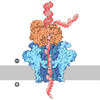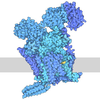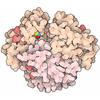+ Open data
Open data
- Basic information
Basic information
| Entry | Database: PDB / ID: 7o1q | ||||||
|---|---|---|---|---|---|---|---|
| Title | Amyloid beta oligomer displayed on the alpha hemolysin scaffold | ||||||
 Components Components | Alpha-hemolysin hybridized Abeta | ||||||
 Keywords Keywords | TOXIN / Amyloid beta oligomer / alpha hemolysin / Alzheimer's Disease | ||||||
| Function / homology |  Function and homology information Function and homology informationcytolysis in another organism / amyloid-beta complex / growth cone lamellipodium / cellular response to norepinephrine stimulus / growth cone filopodium / microglia development / collateral sprouting in absence of injury / Formyl peptide receptors bind formyl peptides and many other ligands / axo-dendritic transport / regulation of Wnt signaling pathway ...cytolysis in another organism / amyloid-beta complex / growth cone lamellipodium / cellular response to norepinephrine stimulus / growth cone filopodium / microglia development / collateral sprouting in absence of injury / Formyl peptide receptors bind formyl peptides and many other ligands / axo-dendritic transport / regulation of Wnt signaling pathway / regulation of synapse structure or activity / axon midline choice point recognition / astrocyte activation involved in immune response / NMDA selective glutamate receptor signaling pathway / regulation of spontaneous synaptic transmission / mating behavior / growth factor receptor binding / peptidase activator activity / Golgi-associated vesicle / PTB domain binding / positive regulation of amyloid fibril formation / Insertion of tail-anchored proteins into the endoplasmic reticulum membrane / Lysosome Vesicle Biogenesis / astrocyte projection / neuron remodeling / Deregulated CDK5 triggers multiple neurodegenerative pathways in Alzheimer's disease models / nuclear envelope lumen / dendrite development / positive regulation of protein metabolic process / TRAF6 mediated NF-kB activation / Advanced glycosylation endproduct receptor signaling / signaling receptor activator activity / negative regulation of long-term synaptic potentiation / modulation of excitatory postsynaptic potential / The NLRP3 inflammasome / transition metal ion binding / main axon / intracellular copper ion homeostasis / regulation of multicellular organism growth / ECM proteoglycans / regulation of presynapse assembly / positive regulation of T cell migration / neuronal dense core vesicle / Purinergic signaling in leishmaniasis infection / positive regulation of chemokine production / cellular response to manganese ion / Notch signaling pathway / clathrin-coated pit / extracellular matrix organization / neuron projection maintenance / Mitochondrial protein degradation / astrocyte activation / ionotropic glutamate receptor signaling pathway / positive regulation of calcium-mediated signaling / positive regulation of mitotic cell cycle / axonogenesis / response to interleukin-1 / protein serine/threonine kinase binding / cellular response to copper ion / platelet alpha granule lumen / cellular response to cAMP / positive regulation of glycolytic process / central nervous system development / endosome lumen / positive regulation of interleukin-1 beta production / dendritic shaft / trans-Golgi network membrane / positive regulation of long-term synaptic potentiation / adult locomotory behavior / learning / positive regulation of JNK cascade / Post-translational protein phosphorylation / locomotory behavior / serine-type endopeptidase inhibitor activity / microglial cell activation / positive regulation of non-canonical NF-kappaB signal transduction / TAK1-dependent IKK and NF-kappa-B activation / regulation of long-term neuronal synaptic plasticity / cellular response to nerve growth factor stimulus / synapse organization / recycling endosome / visual learning / response to lead ion / positive regulation of interleukin-6 production / Golgi lumen / cognition / Regulation of Insulin-like Growth Factor (IGF) transport and uptake by Insulin-like Growth Factor Binding Proteins (IGFBPs) / endocytosis / cellular response to amyloid-beta / positive regulation of inflammatory response / neuron projection development / positive regulation of tumor necrosis factor production / Platelet degranulation / heparin binding / regulation of translation / toxin activity / regulation of gene expression / early endosome membrane / perikaryon / G alpha (i) signalling events Similarity search - Function | ||||||
| Biological species |   Homo sapiens (human) Homo sapiens (human) | ||||||
| Method | ELECTRON MICROSCOPY / single particle reconstruction / cryo EM / Resolution: 3.4 Å | ||||||
 Authors Authors | Wu, J. / Blum, T.B. / Farrell, D.P. / DiMaio, F. / Abrahams, J.P. / Luo, J. | ||||||
 Citation Citation |  Journal: Angew Chem Int Ed Engl / Year: 2021 Journal: Angew Chem Int Ed Engl / Year: 2021Title: Cryo-electron Microscopy Imaging of Alzheimer's Amyloid-beta 42 Oligomer Displayed on a Functionally and Structurally Relevant Scaffold. Authors: Jinming Wu / Thorsten B Blum / Daniel P Farrell / Frank DiMaio / Jan Pieter Abrahams / Jinghui Luo /   Abstract: Amyloid-β peptide (Aβ) oligomers are pathogenic species of amyloid aggregates in Alzheimer's disease. Like certain protein toxins, Aβ oligomers permeabilize cellular membranes, presumably through ...Amyloid-β peptide (Aβ) oligomers are pathogenic species of amyloid aggregates in Alzheimer's disease. Like certain protein toxins, Aβ oligomers permeabilize cellular membranes, presumably through a pore formation mechanism. Owing to their structural and stoichiometric heterogeneity, the structure of these pores remains to be characterized. We studied a functional Aβ42-pore equivalent, created by fusing Aβ42 to the oligomerizing, soluble domain of the α-hemolysin (αHL) toxin. Our data reveal Aβ42-αHL oligomers to share major structural, functional, and biological properties with wild-type Aβ42-pores. Single-particle cryo-EM analysis of Aβ42-αHL oligomers (with an overall 3.3 Å resolution) reveals the Aβ42-pore region to be intrinsically flexible. The Aβ42-αHL oligomers will allow many of the features of the wild-type amyloid oligomers to be studied that cannot be otherwise, and may be a highly specific antigen for the development of immuno-base diagnostics and therapies. | ||||||
| History |
|
- Structure visualization
Structure visualization
| Movie |
 Movie viewer Movie viewer |
|---|---|
| Structure viewer | Molecule:  Molmil Molmil Jmol/JSmol Jmol/JSmol |
- Downloads & links
Downloads & links
- Download
Download
| PDBx/mmCIF format |  7o1q.cif.gz 7o1q.cif.gz | 674.7 KB | Display |  PDBx/mmCIF format PDBx/mmCIF format |
|---|---|---|---|---|
| PDB format |  pdb7o1q.ent.gz pdb7o1q.ent.gz | 558.9 KB | Display |  PDB format PDB format |
| PDBx/mmJSON format |  7o1q.json.gz 7o1q.json.gz | Tree view |  PDBx/mmJSON format PDBx/mmJSON format | |
| Others |  Other downloads Other downloads |
-Validation report
| Summary document |  7o1q_validation.pdf.gz 7o1q_validation.pdf.gz | 776.2 KB | Display |  wwPDB validaton report wwPDB validaton report |
|---|---|---|---|---|
| Full document |  7o1q_full_validation.pdf.gz 7o1q_full_validation.pdf.gz | 787.3 KB | Display | |
| Data in XML |  7o1q_validation.xml.gz 7o1q_validation.xml.gz | 57.2 KB | Display | |
| Data in CIF |  7o1q_validation.cif.gz 7o1q_validation.cif.gz | 79 KB | Display | |
| Arichive directory |  https://data.pdbj.org/pub/pdb/validation_reports/o1/7o1q https://data.pdbj.org/pub/pdb/validation_reports/o1/7o1q ftp://data.pdbj.org/pub/pdb/validation_reports/o1/7o1q ftp://data.pdbj.org/pub/pdb/validation_reports/o1/7o1q | HTTPS FTP |
-Related structure data
| Related structure data |  12696MC M: map data used to model this data C: citing same article ( |
|---|---|
| Similar structure data |
- Links
Links
- Assembly
Assembly
| Deposited unit | 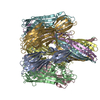
| ||||||||||||||||||||||||||||||||||||||||||||||||
|---|---|---|---|---|---|---|---|---|---|---|---|---|---|---|---|---|---|---|---|---|---|---|---|---|---|---|---|---|---|---|---|---|---|---|---|---|---|---|---|---|---|---|---|---|---|---|---|---|---|
| 1 |
| ||||||||||||||||||||||||||||||||||||||||||||||||
| Noncrystallographic symmetry (NCS) | NCS domain:
NCS domain segments: Component-ID: 1 / Ens-ID: ens_1 / Beg auth comp-ID: ALA / Beg label comp-ID: ALA / End auth comp-ID: ASN / End label comp-ID: ASN / Auth seq-ID: 1 - 293 / Label seq-ID: 1 - 293
|
- Components
Components
| #1: Protein | Mass: 33459.270 Da / Num. of mol.: 7 Source method: isolated from a genetically manipulated source Source: (gene. exp.)   Homo sapiens (human) Homo sapiens (human)Gene: hly, hla, APP, A4, AD1 Production host:  References: UniProt: P09616, UniProt: P05067 |
|---|
-Experimental details
-Experiment
| Experiment | Method: ELECTRON MICROSCOPY |
|---|---|
| EM experiment | Aggregation state: PARTICLE / 3D reconstruction method: single particle reconstruction |
- Sample preparation
Sample preparation
| Component | Name: Abeta42-AHL / Type: COMPLEX / Entity ID: all / Source: RECOMBINANT |
|---|---|
| Source (natural) | Organism:  Homo sapiens (human) Homo sapiens (human) |
| Source (recombinant) | Organism:  |
| Buffer solution | pH: 8 Details: 50 mM Tris-HCl, pH 8.0, 500 mM NaCl, 250 mM imidazole and 0.38 mM DDM |
| Specimen | Conc.: 4.83 mg/ml / Embedding applied: NO / Shadowing applied: NO / Staining applied: NO / Vitrification applied: YES |
| Specimen support | Grid material: GOLD |
| Vitrification | Cryogen name: ETHANE |
- Electron microscopy imaging
Electron microscopy imaging
| Experimental equipment |  Model: Titan Krios / Image courtesy: FEI Company |
|---|---|
| Microscopy | Model: FEI TITAN KRIOS |
| Electron gun | Electron source:  FIELD EMISSION GUN / Accelerating voltage: 300 kV / Illumination mode: FLOOD BEAM FIELD EMISSION GUN / Accelerating voltage: 300 kV / Illumination mode: FLOOD BEAM |
| Electron lens | Mode: BRIGHT FIELD |
| Image recording | Electron dose: 55 e/Å2 / Film or detector model: GATAN K2 SUMMIT (4k x 4k) |
- Processing
Processing
| Software |
| ||||||||||||||||||||||||||||||||||||||||||
|---|---|---|---|---|---|---|---|---|---|---|---|---|---|---|---|---|---|---|---|---|---|---|---|---|---|---|---|---|---|---|---|---|---|---|---|---|---|---|---|---|---|---|---|
| CTF correction | Type: PHASE FLIPPING AND AMPLITUDE CORRECTION | ||||||||||||||||||||||||||||||||||||||||||
| 3D reconstruction | Resolution: 3.4 Å / Resolution method: FSC 0.143 CUT-OFF / Num. of particles: 141366 / Symmetry type: POINT | ||||||||||||||||||||||||||||||||||||||||||
| Refinement | Cross valid method: NONE Stereochemistry target values: GeoStd + Monomer Library + CDL v1.2 | ||||||||||||||||||||||||||||||||||||||||||
| Displacement parameters | Biso mean: 59.28 Å2 | ||||||||||||||||||||||||||||||||||||||||||
| Refine LS restraints |
| ||||||||||||||||||||||||||||||||||||||||||
| Refine LS restraints NCS |
|
 Movie
Movie Controller
Controller




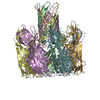
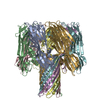


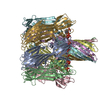

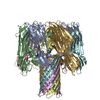
 PDBj
PDBj

